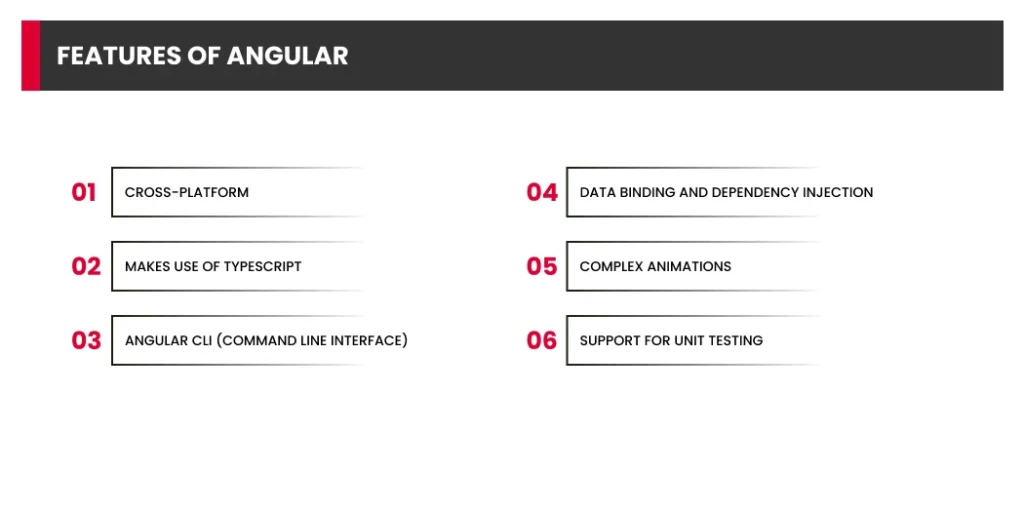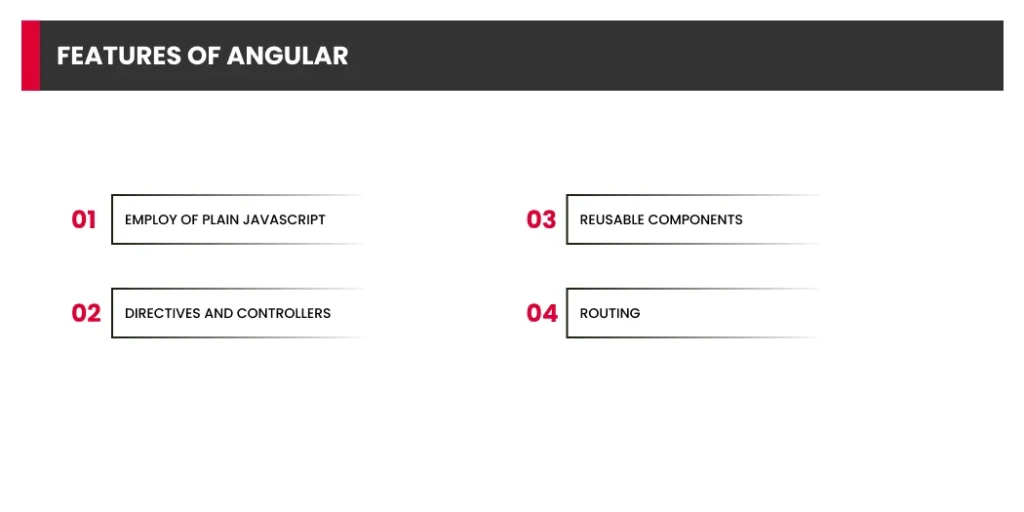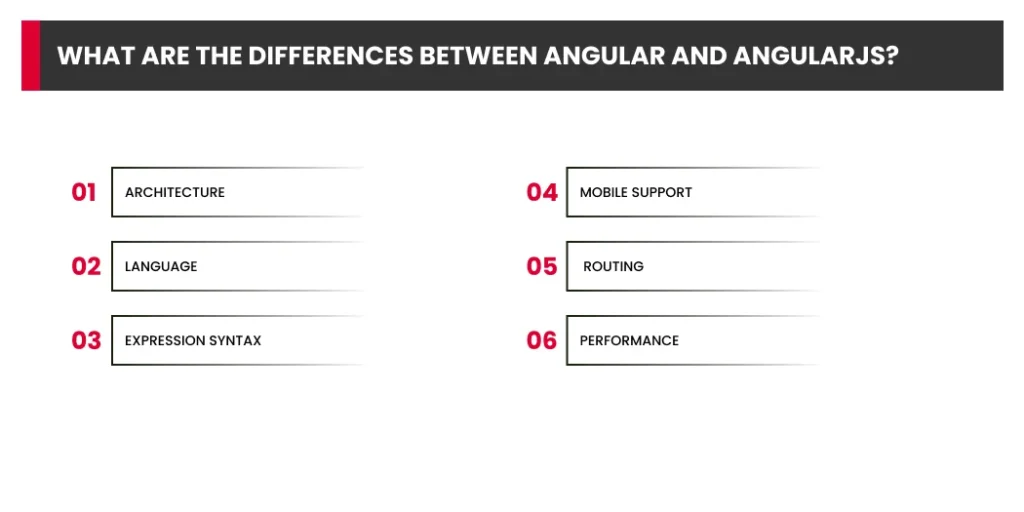Role of Python Libraries in Image Processing
October 30, 2025
Home >> AngularJS >> Difference Between Angular and AngularJS

The technologies that power the Internet have a tendency to advance, adapt, and evolve quickly as needs alter and programmers create better iterations of the software. Consider Angular, which has seen significant modifications in recent years. Version 1.0 of AngularJS, which Google created in 2009, was released in 2012. Since then, Angular has ruled the open-source JavaScript framework world, enjoying fervent support and wide-spread adoption among both businesses and people. As a result, in just five years, Angular has developed from AngularJS version 1.0 to Angular version 2.0, and finally to Angular version 4.0.
If you are trying to figure out what is the difference between Angular and AngularJs then you are at the right place. Discover what has changed in Angular and why upgrading to the most recent version is a smart move by reading on.

A web framework called Angular is open-source and totally cost-free to use. Despite being a JS-based framework, TypeScript is its main programming language. TypeScript, created by Microsoft, is a superset of JavaScript, which essentially means that it contains all the features that JS offers plus a few more. The main purpose of Angular is to create fully working online applications. In September 2016, Google’s tech behemoth Angular made its initial public release. Version 2 serves as Angular’s foundation, while Version 12—also known as Angular 12—is the most recent release. An excellent choice for building robust web apps with contemporary design and extremely dynamic behaviour is a well-known framework.
Since Angular is modular in design, you may break up the entire application into smaller units (referred to as modules) that each represent a specific functionality. As long as you stick with the MVC architecture, Angular makes it simple to create high-performance web apps and provides two-way data binding.
Want to take your web app to the next level?
As Angular development company we can help you to build dynamic, scalable, and responsive web apps that can take your business to the next level.
Let’s first clarify each angular variation with a description before diving into the differences:
An open-source front-end web application framework for developing dynamic web apps is called AngularJS. It is built on JavaScript. HTML is used as the template language. Using directives to enhance HTML attributes and expressions to bind data to HTML, AngularJS develops a readable, incredibly expressive, and speedy environment.
The general phrase used to describe Angular 2, Angular 4, and all other versions that follow AngularJS is “Angular 2.” Both Angular 2 and Angular 4 are open-source front-end web application frameworks built on TypeScript.
The most recent Angular version is 4. There aren’t many differences between Angular 2 and Angular 4 despite the fact that Angular 2 was a complete redesign of AngularJS. Angular 4 merely enhances Angular 2 and is backwards compatible with it.

Angular’s extensive feature set makes it one of the most potent JavaScript web frameworks available. The top JS web framework simplifies the development process while facilitating the creation of contemporary, high-performance apps. The following are Angular’s standout characteristics that you need to be aware of:
With Angular, you can design gorgeous user interfaces for desktop and native mobile applications in addition to web applications. Additionally, the framework is helpful if you want to create software for the Windows, macOS, and Linux operating systems.
Because TypeScript is a statically-typed language, it is superior to JavaScript and is used by Angular. As the types of variables are predefined, it means that there will be less errors made during compilation. Additionally, any JavaScript code is legitimate TypeScript code. Additionally, learning TypeScript would be simple if you already knew JavaScript.
The development process can be accelerated with the help of Angular CLI. Using Angular’s native CLI, you can complete a variety of activities, from project setup to adding components and services.
Adding dynamic behaviour to Angular-developed web pages is made possible by the data binding capability. Two-way data binding often takes place between the model and view components. In other words, any changes you make to the view or UI elements will instantly be mirrored in the model or domain logic. The opposite is also true.
On the other hand, the dependency injection functionality enables the creation of entities that may manage component dependencies. For instance, services in Angular can carry out specific activities like data retrieval from the server and user input validation. The technique of making a service available to a component is called as dependency injection, and you can make these tasks available to numerous components at once.
Angular offers a wide range of functionality for advanced animations. As a developer, you can quickly add a variety of animations to your application without having to write a lot of complicated code. It is very easy to add animations to various UI parts because to its specific functional API for animations.
Angular makes it relatively simple to perform unit tests, ensuring that your code has few errors. The Karma test runner is used by the web framework for rapid and simple troubleshooting.

An AngularJS developer is a JavaScript developer who predominantly uses Angular Java coding to create single-page applications (SPAs). Everything a website visitor sees or hears on a webpage is the work of these pros. These experts do the following tasks in addition to developing SPAs:

Prior to the introduction of Angular 2, AngularJS was widely utilised to build effective web apps. Because AngularJS has so many capabilities, it enables quicker development while simultaneously ensuring improved code maintainability. The following are AngularJS’s standout characteristics:
AngularJS does not employ TypeScript and instead uses the JavaScript programming language. Additionally, the framework employs standard JavaScript, therefore the models in AngularJS are just regular JavaScript objects. This functionality makes it simple to test and manage AngularJS code.
In AngularJS, the directives and controllers provide you the power to choose the functionality and have total control over how an application behaves.
The DOM (Document Object Model) controllers let you specify how DOM elements should behave. You can specify how particular DOM elements should behave. Contrarily, directives are directly inserted into the HTML code to integrate certain application functionality. It’s vital to remember that while directives are used directly within the (HTML) templates, controllers are built independently.
You can build reusable components using AngularJS that you can utilise repeatedly in an application. You must utilise directives when building these components. A component may stand in for a certain capability.
Routing is a feature that enables users to switch between various application views. Routing, put simply, enables users to move between distinct web pages or portions of an online application. Users can transition between multiple views in single-page Angular applications without having to reload the entire app or web page.
Also Read : 15 Benefits of Using AngularJS for Web Development

Directives are used by both Angular and AngularJS, although how they are used differs. While AngularJS includes a pack of them, Angular has standard Directives. When using the Directives, one must use caution. For instance, you must utilise the ng-model in AngularJS when you wish to construct a two-way binding. You’ll use ng-bind for one-way binding.
Now let’s see a difference between AngularJs and Angular to determine which one is best option for you. You will only find the ngModel in Angular. The one-way binding symbol is “[],” and the two-way binding symbol is “[()].” While “()” is used for event binding, “[]” is used for property binding.
AngularJS
Model-view-controller (MVC) architecture is used by AngularJS and serves as the main building block for managing data, logic, and rules as well as expressing how the applications operate. The MVC architecture was the foundation for the majority of SPAs at the time that AngularJS was widely used. What the MVC architecture actually means is as follows:
Model: The model is where all of the data management is kept.
View: After examining the data in the model, the view generates the output.
Controller: After receiving input, the controller transforms it into commands that are then sent to the model and view.
Angular
Directive-based components with templates are used by Angular. Angular has two different categories of directives.
By swapping out its elements, structural directives change how the DOM is laid out.
The DOM’s behaviour and an element’s appearance are changed by attribute directives.
It’s interesting to observe that Angular’s architecture differs greatly from AngularJS’s. It might be a little simpler for you to convert your AngularJS application’s UI and logical abstractions later on if you’ve done so. Additionally, Angular is compatible with the more well-liked and reliable component-based architecture that many contemporary front-end frameworks use.
Looking for an Angular development team that can deliver your project on time?
Hire our Angular developers who have a proven track record of delivering high-quality Angular apps on time.
AngularJS
Written in JavaScript, AngularJS.
Angular versions
Microsoft’s TypeScript language, a superset of JavaScript, is used by Angular. This has benefits similar to type declarations and those of ES6, such as iterators and lambdas.
The most recent versions of TypeScript, which contain robust type checking and object-oriented capabilities, are compatible with Angular 4.
AngularJS
You must keep in mind the suitable ng directive while using AngularJS to bind an image/property or an event.
Angular versions
In Angular, “()” is used for event binding while “[]” is used for property binding.
Mobile support is a feature of Angular, Angular 2, and Angular 4, but AngularJS was not designed with it in mind.
AngularJS utilises $routeprovider.when() while Angular uses @RouteConfig(…) to configure routing.
AngularJS was first created for designers rather than developers. Although its design saw a few evolutionary changes, these were insufficient to meet developer demands. Performance has been improved overall with the newer versions, Angular 2 and Angular 4, particularly in terms of speed and dependency injection.
Speed
AngularJS decreased the time and effort required for development by offering features like 2-way binding. Page loading was taking a long time since additional processing was being done on the client side. A stronger change detection system and improved structure are provided by Angular2 to make it easier to design and maintain large apps. The quickest version so far is Angular 4.
Dependency Injection
Angular leverages the Hierarchical Dependency Injection mechanism with unidirectional tree-based change detection. This greatly improves the performance of the framework.
See the Angular and AngularJS difference in the form of their advantages as well as disadvantages. Let us go through the advantages and disadvantages of angular vs angular js:
Modularity:
By moving the majority of Angular’s core functionality to several modules, the core was made lighter and faster.
Dynamic Loading:
A combination of asynchronous templates and additional reactive programming features is available.
AOT/Ahead-of-Time:
During the build process, this compilation aids in the conversion of the HTML and TypeScript into JavaScript. For quicker rendering, AOT compiles the code and the browser loads it.
CLI:
The Command Line Interface (CLI) is a tool for building and running Angular apps. It handles project development and facilitates testing.
The Architectural Component:
This aids in separating the logical and functional components.
Dependency Injection:
Angular employs unidirectional change detection for dependency injection. In order to dramatically improve the efficiency of the framework, Angular uses Hierarchical Dependency Injection rather than directives like AngularJS does.
Language:
Although Angular is written in TypeScript, there are alternative options for authoring programmes, including ES5, ES6, and Dart.
Routing:
The Angular framework includes a straightforward path for routing. It is capable of interpreting a URL as a command to go to a client view.
Despite difference between angular and angularjs, Angular and AngularJS both have advantages. Angular has a sizable community following because Google currently exclusively maintains it. Since Google no longer officially supports AngularJS, community support is minimal. It’s a good idea to start switching your existing AngularJS applications over to Angular now if you want to build dynamic applications for the web and mobile devices using TypeScript and HTML.
The Angular team has made it incredibly simple to migrate to and upgrade to more recent versions of Angular when they are released. The whole upgrade guide is available in their official documentation.
One of the most popular comparisons that JavaScript developers look for is Angular vs Angular.JS. I hope that all doubts about Angular vs AngularJS is solved now. Even though they are both robust JavaScript frameworks created by Google, you should be aware of certain key distinctions before selecting one of them to use for a project. We did our best through this article to assist you in clearly understanding the differences between Angular and AngularJS based on numerous characteristics.
Simply remember that Angular is the replacement for AngularJS and offers superior performance and functionality. Even if AngularJS is frequently updated with new improvements, it just cannot keep up with the cutting-edge features provided by Angular. Therefore, in our humble opinion, Angular is preferable to AngularJS, especially if you want to create cutting-edge web apps with improved functionalities.
The robust web framework Angular enables client-side or front-end programming. It is a framework built on TypeScript that programmers can use to create the user interface for applications. It also manages communications between users and programmes.
In December 2021, Google will stop providing support for AngularJS. On the other hand, improvements for Angular will improve security and functionality. You can therefore assume that while Angular will continue to compete with the most recent web frameworks, AngularJS will soon become obsolete.
One of the most well-liked JavaScript web development frameworks for creating contemporary web applications is Angular. Large software companies frequently choose to create intricate, feature-rich programmes. As a result, there is a substantial need for Angular developers on the job market, making it a wise choice to study Angular.

Digital Valley, 423, Apple Square, beside Lajamni Chowk, Mota Varachha, Surat, Gujarat 394101
D-401, titanium city center, 100 feet anand nagar road, Ahmedabad-380015
+91 9913 808 2851133 Sampley Ln Leander, Texas, 78641
52 Godalming Avenue, wallington, London - SM6 8NW